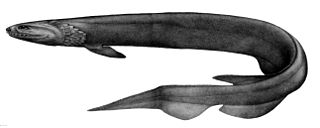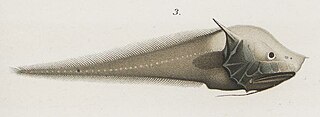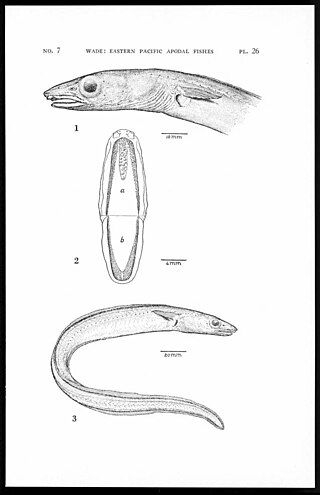
The frilled shark, also known as the lizard shark, is one of the two extant species of shark in the family Chlamydoselachidae. The frilled shark is considered a living fossil, because of its primitive, anguilliform (eel-like) physical traits, such as a dark-brown color, amphistyly, and a 2.0 m (6.6 ft)–long body, which has dorsal, pelvic, and anal fins located towards the tail. The common name, frilled shark, derives from the fringed appearance of the six pairs of gill slits at the shark's throat.

Eels are ray-finned fish belonging to the order Anguilliformes, which consists of eight suborders, 20 families, 164 genera, and about 1000 species. Eels undergo considerable development from the early larval stage to the eventual adult stage and are usually predators.

Venefica is a genus of eels in the duckbill eel family Nettastomatidae. It currently contains the following species:

The bony-eared assfish is a bathypelagic species of cusk-eel found in tropical and sub-tropical oceans at depths of from 1,171 to 4,415 metres. It has been found as far north as Queen Charlotte Sound off British Columbia's coast. This species grows to a length of 37.5 centimetres (14.8 in) SL. The larvae are similar in overall form to the related gargoyle cusk, but have elongated 3rd, 4th, and 5th pectoral-fin rays.
Chlopsis longidens is an eel in the family Chlopsidae. It was described by Samuel Garman in 1899, originally under the genus Atopichthys. It is known from a single leptocephalus specimen collected from between Ecuador and the Galapagos Islands, in the central eastern Pacific Ocean. From that specimen. the species is known to dwell in a tropical, marine climate at a maximum depth of 3,184 m. The specimen may possibly be a larval bicolor false moray.
The slope conger, also known as the black-fin conger, is an eel in the family Congridae. It was described by Charles Henry Gilbert in 1891, originally under the genus Ophisoma. It is a marine, deep water-dwelling eel which is known from the southeastern and eastern central Pacific Ocean, including Colombia, Ecuador, Costa Rica, Honduras, El Salvador, Mexico, Guatemala, Nicaragua, Panama, and Peru. It is known to dwell at a depth range of 380–740 metres, and inhabits substrates. Males can reach a maximum total length of 35 centimetres.
The shortsnout conger, also known as the thicklip conger, is an eel in the family Congridae. It was described by Samuel Garman in 1899, originally under the genus Atopichthys. It is a tropical, marine eel which is known from the eastern central Pacific Ocean, including Colombia, Costa Rica, Ecuador, El Salvador, Guatemala, Honduras, Mexico, Nicaragua, and Panama. It leads a reclusive, benthic, burrowing lifestyle, and typically dwells at a depth range of 27–2198 metres. Males can reach a maximum total length of 30 centimetres.
Paraconger ophichthys is an eel in the family Congridae. It was described by Samuel Garman in 1899, originally under the genus Atopichthys. It is a tropical, marine eel which is known from Cocos Island, in the eastern central Pacific Ocean. It is known to dwell at a depth of 1953 metres.
The largehead conger is an eel in the family Congridae. It was described by Samuel Garman in 1899, originally under the genus Uroconger. It is a marine, deep water-dwelling eel which is known from southern Canada to Chile, in the eastern Pacific Ocean. It dwells at a depth range of 165–935 metres. Males can reach a maximum total length of 100 centimetres.
The neighbor conger is an eel in the family Congridae. It was described by Samuel Garman in 1899, originally under the genus Uroconger. It is a marine, deep water-dwelling eel that is known from the southwestern and western central Atlantic Ocean, including the Bahamas, Brazil, Cuba, and Mexico. It dwells at a depth range of 101–503 metres (331–1,650 ft). Males can reach a maximum total length of 46.2 centimetres (18.2 in).

Gnathophis cinctus, the hardtail conger or Catalina conger, is an eel in the family Congridae. It was described by Samuel Garman in 1899, originally under the genus Atopichthys. It is a tropical, marine eel which is known from the eastern central and southeastern Pacific Ocean, including Chile, Colombia, Costa Rica, Ecuador, El Salvador, Guatemala, Honduras, Mexico, Nicaragua, Panama, Peru, and the United States. It dwells at a depth range of 9–336 metres, and leads a benthic lifestyle, burrowing into loose sand. Males can reach a maximum total length of 42 cm.
Hoplunnis sicarius is an eel in the family Nettastomatidae. It was described by Samuel Garman in 1899, originally under the genus Atopichthys. It is a marine, tropical eel which is known from the eastern central Pacific Ocean, including Mazatlan, Mexico, and Panama. It is known to dwell at a depth of 1,431 metres (4,695 ft), and inhabits substrates. Unlike many eel species, it does not form burrows.
Venefica multiporosa is a species of eel in the family Nettastomatidae. It was described by Christine Karrer in 1983. It is a marine, deep water-dwelling eel which is known from the Indo-western Pacific, including Madagascar, Australia and the Philippines. It dwells at a depth range of 416 to 1,300 metres. Males can reach a maximum total length of 70 centimetres (28 in).
Venefica ocella is an eel in the family Nettastomatidae. It was described by Samuel Garman in 1899. It is a marine, deep water-dwelling eel which is known from the eastern Pacific Ocean. It is known to dwell at a depth of 1,953 metres (6,407 ft).
The whipsnout sorcerer is an eel in the family Nettastomatidae. It was described by Léon Vaillant in 1888, originally under the genus Nettastoma. It is a marine, deep water-dwelling eel which is known from tropical, subtropical and temperate areas throughout the world. It dwells at a depth range of 385 to 2,200 metres, and inhabits the lower region of the continental slope. Males can reach a maximum total length of 100 centimetres (39 in).

Venefica procera is an eel in the family Nettastomatidae. It was described by George Brown Goode and Tarleton Hoffman Bean in 1883, originally under the genus Nettastoma. It is a marine, deep water-dwelling eel which is known from the western central Atlantic Ocean, including North Carolina, USA, Suriname, the Gulf of Mexico and the Caribbean Sea. It dwells at a depth range of 326 to 2,304 meters. Males can reach a maximum total length of 109 centimeters (43 in).
The death-banded snake eel is an eel in the family Ophichthidae. It was described by Samuel Garman in 1899. It is a tropical, marine eel which is known from the eastern central and southeastern Pacific Ocean, including the central Gulf of California, Colombia, Costa Rica, Mexico and Panama. It dwells at a depth range of 35–760 metres, and forms burrows in sandy and muddy bottoms. Males can reach a maximum total length of 86 centimetres.
Avocettina bowersii is an eel in the family Nemichthyidae. It was described by Samuel Garman in 1899. It is a marine, deep water-dwelling eel which is known from California, U.S.A.; Peru, and Chile. It dwells at a depth range of 92–641 metres, although the type specimen was collected from a depth of 2,692 metres.

Serrivomer sector, known commonly as the sawtooth eel, the saw-tooth snipe or the deep-sea eel, is an eel in the family Serrivomeridae. It was described by Samuel Garman in 1899. It is a marine, deep water-dwelling eel which is known from the eastern and western Pacific Ocean, including Japan, Chile, and California, USA. It dwells at a depth range of 0 to 3,243 metres, most often around 305 metres (1,001 ft). Males can reach a maximum total length of 76 centimetres (30 in).
Leptochilichthys agassizii, or Agassiz' smooth-head, is a species of fish in the family Alepocephalidae. It is named for the scientist and engineer Alexander Agassiz (1835–1910), who commanded the 1899 survey aboard the USS Albatross on which the fish was discovered.








